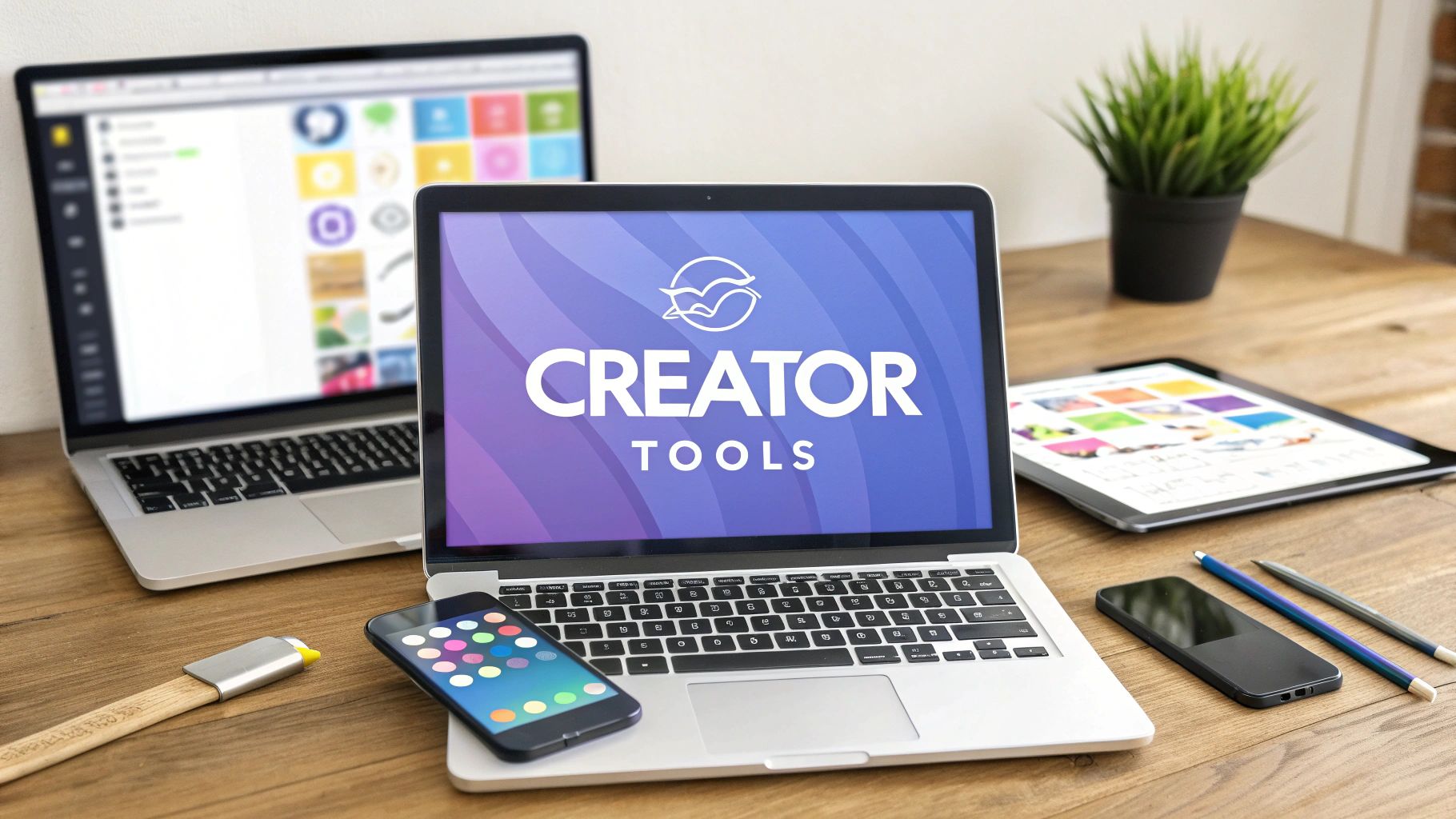A killer advertisement starts long before the cameras roll or the graphics are designed; it begins with a powerful script. The right words, structure, and tone can mean the difference between an ad that gets scrolled past and one that captivates, persuades, and converts. Yet, many marketers and business owners struggle to find the right formula to grab and hold attention.
This guide is built to solve that problem. We will break down six proven advertisement script example frameworks that have powered countless successful campaigns. Instead of just showing you a template, we will dissect each one, providing actionable analysis and strategic takeaways you can apply to your own projects immediately. You'll learn the core mechanics behind what makes a script effective, from grabbing attention in the first three seconds to driving a clear call to action.
Mastering these frameworks will give you a repeatable process for creating compelling ads that resonate with your target audience and deliver tangible results. Beyond mastering the various ad script frameworks, gaining an understanding of how to make a video go viral can elevate your content's impact and reach significantly. Whether you're scripting for social media, a B2B presentation, or a product showcase, these structures provide the foundation you need for success.
1. The Classic Closer: AIDA Formula (Attention, Interest, Desire, Action) Script
The AIDA formula is a cornerstone of marketing and advertising for a reason: it works. This time-tested framework provides a logical and psychological path to guide a potential customer from initial awareness to a final purchasing decision. It’s a powerful tool for structuring a persuasive advertisement script example because it aligns perfectly with the consumer's decision-making process.
The model is built on four sequential stages:
- Attention: Grab the viewer's focus immediately.
- Interest: Hold that focus by presenting relevant, compelling information.
- Desire: Transform interest into a want by connecting the product to emotional benefits.
- Action: Tell the audience exactly what to do next.
Advertisement Script Example: "GlowUp" Skincare Serum
Let's break down an AIDA script for a fictional skincare product called "GlowUp."
(Video opens with a close-up shot of a person looking tiredly at their dull skin in the mirror. Text on screen: "Tired of dull, lifeless skin?")
- Attention: The opening visual and direct question immediately hook viewers who relate to the problem. It’s a common pain point presented simply and effectively.
(Scene cuts to a vibrant, animated graphic showing how skin cells lose their glow. A friendly, upbeat voiceover begins.)
- Voiceover: “Every day, environmental stressors and lack of sleep can rob your skin of its natural radiance. But what if you could fight back?”
- Interest: This section provides a simple explanation of the problem, building curiosity and validating the viewer's experience. It transitions from the problem to the possibility of a solution.
(The product, "GlowUp," is revealed in a beautiful, well-lit shot. A person is shown applying the serum, and their face transforms from dull to bright and dewy.)
- Voiceover: “Introducing GlowUp, the revolutionary serum with our patented Hyalu-C Complex. Imagine waking up to skin that’s not just brighter, but visibly plumper and smoother. Feel the confidence that comes with a naturally radiant complexion.”
- Desire: Here, the script connects features (Hyalu-C Complex) to emotional benefits (confidence, radiance). The visual transformation helps the audience desire that same result for themselves.
(The final shot shows the product next to a call-to-action button on a clean background.)
- Voiceover: “Don’t wait for great skin. Click the link below to get your GlowUp serum today and receive 15% off your first order. Your glow-up is just a click away.”
- Action: The call-to-action (CTA) is direct, clear, and urgent. The 15% discount provides a compelling incentive to act immediately.
Strategic Takeaways
This AIDA structure is incredibly versatile and works well for video ads, landing pages, and even email campaigns. It’s particularly effective for products that solve a clear and relatable problem. By moving the audience logically from a pain point to a desirable solution and then providing a simple next step, you create a persuasive and frictionless path to conversion.
2. Problem-Solution-Benefit (PSB) Script
The Problem-Solution-Benefit (PSB) framework is a direct and highly effective approach to persuasion. It hooks the audience by tapping into a genuine pain point they experience, presents your product as the perfect remedy, and then closes the loop by detailing the positive outcomes they'll enjoy. This structure is a powerful choice for an advertisement script example because it's built on empathy and clear value.

This model cuts straight to the chase with three core stages:
- Problem: Clearly identify and agitate a specific problem your target audience faces.
- Solution: Introduce your product or service as the ideal answer to that problem.
- Benefit: Explain the tangible and emotional advantages the customer gains from using your solution.
Advertisement Script Example: "SyncUp" Project Management Tool
Let's apply the PSB framework to a fictional SaaS product called "SyncUp," designed for small teams.
(Video opens with quick cuts of a frustrated project manager. We see missed deadlines on a calendar, confusing email chains, and a team member looking stressed during a video call.)
- Problem: The opening scene instantly establishes a relatable and frustrating scenario. The visuals of email overload and stressed colleagues resonate deeply with anyone who has managed a team project, making the problem feel immediate and real.
(The scene transitions smoothly to the clean, organized SyncUp dashboard. A calm, confident voiceover begins.)
- Voiceover: “Juggling projects shouldn’t feel like a chaotic mess. Meet SyncUp, the all-in-one platform that brings your team’s tasks, conversations, and files into one organized space.”
- Solution: This section directly presents SyncUp as the answer to the chaos shown moments before. The voiceover is reassuring, and the visual of the organized dashboard provides a clear contrast to the previous scene.
(We see a graphic showing a "30% Faster Project Completion" stat. The final shot is of the same team, now smiling and high-fiving as they successfully complete a project on a screen showing the SyncUp interface.)
- Voiceover: “Stop wasting time searching for updates and start hitting your deadlines with ease. With SyncUp, you’ll not only improve your team's productivity but also create a calmer, more collaborative work environment. Sign up for your free trial today.”
- Benefit: The script outlines specific, desirable outcomes: faster project completion (a tangible benefit) and a less stressful work environment (an emotional benefit). The call-to-action is simple and low-risk ("free trial").
Strategic Takeaways
The PSB model is exceptionally effective for brands that solve a distinct and well-understood problem. It works wonders for B2B services, tech gadgets, and any product designed to make life easier. The key is to genuinely understand your audience's pain points and articulate your solution's benefits in a way that provides clear relief and tangible value.
3. Storytelling/Narrative Script
Humans are wired for stories. A narrative script leverages this innate connection by using characters, conflict, and resolution to create an emotional bond with the audience. Instead of a direct sales pitch, this approach weaves the product or service into a meaningful journey, making the brand an integral part of a memorable story.
This technique moves beyond features and benefits to tap into universal themes like love, perseverance, and triumph. By focusing on a relatable protagonist overcoming a challenge, the brand becomes the hero's trusted ally, and the advertisement script example feels less like a commercial and more like a short film.

Advertisement Script Example: "The Journey" for Trailblazer Hiking Boots
Let's outline a narrative script for "Trailblazer," a fictional brand of durable hiking boots.
(Video opens on a young woman, ANNA, looking nervously at a steep, imposing mountain trail map in her small apartment. Her old, worn-out boots are next to it.)
- Character & Conflict: We immediately meet our protagonist, Anna, and understand her goal (climbing the mountain) and her obstacle (self-doubt, inadequate gear). Viewers can relate to the feeling of facing a daunting challenge.
(Montage sequence: Anna trains, running in the rain and doing push-ups. She researches online and buys a pair of Trailblazer boots. She’s shown unboxing them, a look of determination on her face.)
- Voiceover (Anna’s inner thought): “They said the summit was for the experts. For the fearless. But fear is just a story you tell yourself.”
- Rising Action: The brand is introduced not as a magical solution but as a crucial tool Anna chooses to help her on her journey. The focus remains on her effort and commitment.
(Anna is on the trail. She stumbles on loose rocks but the Trailblazer boots hold firm. She crosses a shallow stream, and her feet stay dry. A shot shows her smiling, gaining confidence.)
- Voiceover: “Every step is a new word. Every climb, a new sentence. And with each one, you rewrite your own story.”
- Climax & Resolution: The product's features (grip, waterproof) are shown organically, helping Anna overcome mini-challenges. The resolution isn't just reaching the summit; it's her personal transformation into a more confident person.
(Final shot: Anna stands at the mountain peak at sunrise, looking out with a sense of accomplishment. The Trailblazer logo and tagline "Forge Your Path" appear on screen.)
- Thematic Tie-in: The final scene provides an emotional payoff. The brand isn't the hero; Anna is. The boots were the reliable partner that enabled her success. The tagline connects the product directly to the theme of personal achievement.
Strategic Takeaways
A narrative script is exceptionally powerful for building brand affinity and loyalty. It works best for brands that want to associate themselves with specific values like courage, family, or innovation. By telling a compelling story, you sell an emotion and an identity, not just a product. This makes the message more memorable and shareable, creating a lasting impact far beyond a simple call to action.
4. The Testimonial/Social Proof Script
The Testimonial or Social Proof script is a powerful advertising strategy that leverages the voice of the customer. Instead of the brand making claims, this format uses authentic user experiences to build trust and credibility. It operates on the principle of social proof, a psychological phenomenon where people assume the actions of others reflect correct behavior for a given situation.
This approach is effective because it’s authentic and relatable. A genuine story from a real person often resonates more deeply than polished corporate messaging.
- Authenticity: Real customer stories feel more trustworthy than a brand talking about itself.
- Relatability: Potential buyers see people like themselves succeeding with the product.
- Validation: It provides third-party validation for your product's claims.
- Emotion: Personal stories connect on an emotional level, making the message more memorable.
Advertisement Script Example: "Peloton Member Story"
Let's break down a testimonial advertisement script example for a fictional Peloton member named "Maria."
(Video opens with a warm, intimate shot of Maria in her home, smiling. Text on screen: "Maria's Story.")
- Voiceover (Maria): "Before Peloton, my biggest challenge was just finding the time. With two kids and a full-time job, the gym felt like a world away."
- Authenticity: The script starts with a relatable problem. It establishes Maria as a real person with common struggles, immediately connecting with a similar target audience.
(Cut to B-roll footage of Maria's busy life: packing lunches, working at a desk, then looking at the Peloton bike in her living room. She gets on the bike and starts a class.)
- Voiceover (Maria): "Having the bike at home changed everything. I could hop on for a 20-minute ride whenever I had a moment. The instructors felt like they were right there, cheering me on."
- Relatability: This section highlights the convenience and unique selling proposition of the product (at-home fitness) through the user's experience. It focuses on the solution to her initial problem.
(Footage shows Maria looking energized and happy after a workout. She's playing with her kids, full of life. A graphic shows a specific result: "Lost 25 lbs in 6 months.")
- Voiceover (Maria): "It wasn't just about losing weight, though I did. It was about feeling strong again, for myself and for my family. I have so much more energy now. It truly gave me a part of myself back."
- Validation: The specific, measurable result ("Lost 25 lbs") provides concrete proof. The focus then shifts to the powerful emotional benefit (feeling strong, more energy), which is the true selling point.
(Final shot of Maria smiling at the camera.)
- Voiceover (Announcer): "Discover your strength. Start your Peloton journey today."
- Action: The call-to-action is simple and aspirational, tying the brand's tagline to Maria's emotional journey. It invites the viewer to experience a similar transformation.
Strategic Takeaways
This script structure works because it puts the customer's transformation front and center. To streamline the creation of powerful testimonial scripts, a dedicated video testimonial script generator can be an invaluable tool. It’s highly effective for brands in fitness, wellness, B2B SaaS, and any industry where results and customer success stories are key differentiators. By showcasing real results from real people, you build a powerful case for your product that advertising claims alone cannot match. For more inspiration, you can learn more about successful testimonial ad campaigns.
5. The Challenger: Comparison/Competitive Script
A comparison script is a bold advertising strategy that directly or indirectly positions a product against its competitors. This approach works by highlighting superior features, better value, or more significant benefits, giving the audience a clear reason to choose one brand over another. It's an effective way to cut through market noise and disrupt established leaders.
This model is built on creating a clear contrast:
- Establish the Arena: Define the common ground or problem that both your product and the competitor's address.
- Highlight Your Advantage: Clearly demonstrate where your product excels, focusing on a key differentiator.
- Showcase the Benefit: Connect your advantage to a tangible benefit for the customer (e.g., saving time, money, or frustration).
- Deliver the Verdict: Conclude with a clear call to action that positions your product as the obvious winner.
Advertisement Script Example: "SwiftSend" File Transfer Service
Let's break down a competitive advertisement script example for a fictional file transfer service called "SwiftSend," positioning it against a slower, more cumbersome competitor.
(Video opens with a split screen. On the left, a frustrated user ("Competitor User") is staring at a slow-loading progress bar. On the right, a calm user ("SwiftSend User") is sipping coffee. Text on screen: "Still waiting?")
- Establish the Arena: The split-screen immediately sets up a direct comparison. The shared problem is transferring large files, a common pain point for the target audience.
(The Competitor User on the left sighs and taps their fingers impatiently. The loading bar barely moves. A friendly, confident voiceover begins.)
- Voiceover: “We’ve all been there. You’ve got a deadline, but your files are stuck in digital traffic. Why is your old file transfer service so slow?”
- Highlight Your Advantage: This section calls out the competitor's weakness (slowness) while empathizing with the user. It sets the stage to introduce the superior alternative.
(The screen transitions to focus on the SwiftSend User. With a single click, their file upload completes instantly, showing a "Transfer Complete!" message. The user smiles and takes another sip of coffee.)
- Voiceover: “Meet SwiftSend. We built our network for speed and simplicity. No more endless loading bars, just instant, secure transfers. That project you were stressing about? It’s already there.”
- Showcase the Benefit: The script directly connects the feature (speed) to the emotional benefit (relief from stress, efficiency, peace of mind). The visual payoff is immediate and satisfying.
(The final shot shows the SwiftSend logo and a clear call to action on a clean background.)
- Voiceover: “Stop waiting and start sending. Visit SwiftSend.com to transfer your first 10GB for free. Make the switch to speed today.”
- Deliver the Verdict: The CTA is direct and offers a risk-free trial (free 10GB). It frames the decision not just as a choice, but as a clear, logical upgrade.
Strategic Takeaways
Comparison scripts are powerful for challenger brands or products with a distinct, measurable advantage. They work best when the claims are easily verifiable and focus on benefits that genuinely matter to consumers, like speed, cost, or ease of use. Remember to keep claims factual and legally sound to avoid backlash. This direct approach can quickly capture market share by turning a competitor's weakness into your greatest strength.
6. The "Show, Don't Tell" Method: Demonstration/How-It-Works Script
Some products are best understood by seeing them in action. The Demonstration or "How-It-Works" script focuses on showcasing a product's functionality and results, moving beyond mere description to provide tangible proof of its value. This approach is highly effective for innovative gadgets, complex software, or any item whose primary selling point is its superior performance or unique features.

This advertisement script example builds trust and credibility by letting the product speak for itself. The core principle is simple:
- Problem: Present a common, frustrating problem.
- Demonstration: Show the product solving that exact problem effortlessly.
- Result: Display the clear, desirable "after" state.
- Offer: Provide a clear call to action to purchase.
Advertisement Script Example: "StainAway" Carpet Cleaner
Let's break down a classic demonstration script for a fictional carpet cleaner called "StainAway."
(Video opens on a pristine, light-colored carpet. Suddenly, a glass of red wine is knocked over, creating a dramatic, dark stain. A person gasps in frustration.)
- Problem: The opening visual is highly relatable and instantly establishes a high-stakes, common problem. The frustration is palpable, setting the stage for a powerful solution.
(The StainAway bottle is shown. A hand sprays the solution directly onto the wine stain. The voiceover is calm and authoritative.)
- Voiceover: “Spills happen. But they don’t have to ruin your day or your carpet.”
- Demonstration (Part 1): The script immediately introduces the product as the hero. The focus is purely on the action-oriented application, showing how simple it is to use.
(The scene uses a time-lapse or quick cut to show the foam working. The person then takes a simple white cloth and gently blots the area. The stain visibly lifts with each blot, disappearing completely.)
- Voiceover: “StainAway’s active-lift formula targets the stain at the molecular level, breaking it down without harsh scrubbing. Just spray, wait, and blot away.”
- Demonstration (Part 2) & Result: This is the "magic moment." The visual evidence is undeniable, as the stain vanishes before the viewer's eyes. The voiceover provides a simple, benefit-driven explanation of why it works so well.
(Final shot shows the spotless carpet and the StainAway bottle.)
- Voiceover: “Don’t let stains set in. Get StainAway and be prepared for any mess. Order now from our website and get a second bottle free!”
- Offer: The call to action is direct and compelling, reinforced by a strong "buy one, get one" incentive that encourages immediate purchase.
Strategic Takeaways
The demonstration script is a powerhouse for products whose value is best proven visually. It's perfect for social media ads, TV commercials, and e-commerce product pages where you can show a clear before-and-after transformation. This method removes doubt and builds consumer confidence by providing undeniable proof. To learn more about this approach, discover how you can create powerful product demo videos automatically.
6 Advertisement Script Styles Comparison
| Script Type | Implementation Complexity | Resource Requirements | Expected Outcomes | Ideal Use Cases | Key Advantages |
|---|---|---|---|---|---|
| AIDA Formula | Low to moderate | Low to moderate | Clear customer journey progression | Product launches, direct response, email | Simple, proven, adaptable across media |
| Problem-Solution-Benefit (PSB) | Low | Low | Strong relevance and emotional connection | B2B software, healthcare, financial | Conversational, outcome-focused |
| Storytelling/Narrative Script | High | High | Strong emotional engagement and brand affinity | Brand awareness, lifestyle, CSR | Memorable, builds deep brand connection |
| Testimonial/Social Proof | Low to moderate | Moderate | High credibility and trust | High-consideration purchases, B2B, wellness | Builds trust, cost-effective, community |
| Comparison/Competitive | Moderate to high | Moderate | Clear positioning against competitors | Challenger brands, price-competitive markets | Demonstrates confidence, helps decision-making |
| Demonstration/How-It-Works | Moderate to high | High | Reduced confusion, increased confidence | Complex or innovative products, tech demos | Engaging, informative, clarifies function |
From Framework to Final Cut: Bringing Your Script to Life
The journey from a blank page to a high-performing advertisement can feel daunting, but it starts with a solid foundation. As we've explored, having the right advertisement script example isn't just about finding words; it's about choosing the right strategic framework to connect with your audience and achieve your goals. These proven structures are your creative launchpads.
Each framework offers a distinct advantage. The AIDA formula provides a clear, conversion-focused path, while the Problem-Solution-Benefit model speaks directly to a customer's pain points. A Narrative script builds emotional resonance, and a Testimonial script leverages the immense power of social proof to build trust. Meanwhile, a Comparison script can effectively position your brand in a crowded market, and a Demonstration script makes complex value propositions tangible and easy to understand.
Your Blueprint for Actionable Advertising
The most effective advertisers don't see these frameworks as rigid constraints. Instead, they view them as a versatile toolkit. The key is to move from theory to practice by internalizing the core principles behind each script type.
- Align Your Framework with Your Goal: Is your primary objective to generate immediate leads, build brand awareness, or educate a new market? A B2B SaaS company might find a Demonstration script invaluable for a new feature launch, whereas a DTC e-commerce brand could use a Storytelling or Testimonial script to foster a loyal community.
- Mix and Match for Maximum Impact: Don't be afraid to combine elements. You can open a Problem-Solution-Benefit script with a powerful narrative hook or embed a customer testimonial within a product demonstration. The goal is to create an ad that feels authentic to your brand and resonates deeply with your target audience.
- Focus on the Core Message: Regardless of the structure, every successful ad script communicates a single, compelling idea. What is the one thing you want your viewer to remember? Every line, every scene, and every sound should reinforce that central message.
Once you've chosen your framework, the next crucial step is crafting the actual words that will captivate your audience. To truly master the art of compelling ad creation, you'll need to learn how to write a compelling script from idea to final draft. This will help you translate your strategic vision into polished, production-ready copy.
Ultimately, mastering these script examples empowers you to move with confidence and creativity. You are no longer just guessing what might work; you are building on proven psychological principles that drive human connection and inspire action. Use these examples, dissect them, and adapt them to tell your brand’s unique story. The result will be advertising that doesn't just interrupt, but engages, persuades, and converts.
Ready to turn your script into a polished video ad in minutes? Sprello uses AI to help you generate high-quality, professional video content from your script, complete with voiceovers, music, and visuals. Stop staring at a blank timeline and start creating with Sprello today.



